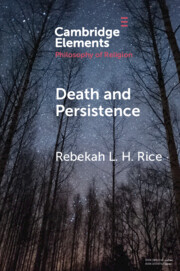51 results

Personal Identity and the Self
-
- Published online:
- 29 November 2024
- Print publication:
- 02 January 2025
-
- Element
-
- You have access
- Open access
- HTML
- Export citation
8 - It’s the Group, Not Just the Individual
- from Part II - Drivers of the Exclusion–Extremism Link
-
-
- Book:
- Exclusion and Extremism
- Published online:
- 16 May 2024
- Print publication:
- 23 May 2024, pp 166-183
-
- Chapter
- Export citation
When Suicide is not a Self-Killing: Advance Decisions and Psychological Discontinuity—Part I
-
- Journal:
- Cambridge Quarterly of Healthcare Ethics , First View
- Published online by Cambridge University Press:
- 24 April 2024, pp. 1-12
-
- Article
-
- You have access
- Open access
- HTML
- Export citation
1 - Introduction
-
- Book:
- Personal Ontology
- Published online:
- 07 March 2024
- Print publication:
- 14 March 2024, pp 1-18
-
- Chapter
- Export citation

Personal Ontology
- Mystery and Its Consequences
-
- Published online:
- 07 March 2024
- Print publication:
- 14 March 2024
Master Narratives, Self-Simulation, and the Healing of the Self
-
- Journal:
- Journal of the American Philosophical Association / Volume 10 / Issue 1 / March 2024
- Published online by Cambridge University Press:
- 12 April 2023, pp. 153-167
-
- Article
- Export citation
Citizenship, Identity, and Veiling: Interrogating the Limits of Article 8 of the European Convention on Human Rights in Cases Involving the Religious Dress of Muslim Women
-
- Journal:
- Journal of Law and Religion / Volume 38 / Issue 1 / January 2023
- Published online by Cambridge University Press:
- 19 January 2023, pp. 81-107
-
- Article
-
- You have access
- Open access
- HTML
- Export citation
Personal identity: How it moderates the relation between social identity and workplace performance
-
- Journal:
- Journal of Management & Organization / Volume 30 / Issue 6 / November 2024
- Published online by Cambridge University Press:
- 22 December 2022, pp. 1845-1872
-
- Article
- Export citation
Chapter 8 - The Demand for Authenticity
- from Part III - Politics and Authenticity
-
- Book:
- Heidegger's Social Ontology
- Published online:
- 18 February 2023
- Print publication:
- 24 November 2022, pp 225-257
-
- Chapter
- Export citation
Brain-State Transitions, Responsibility, and Personal Identity
-
- Journal:
- Cambridge Quarterly of Healthcare Ethics / Volume 31 / Issue 4 / October 2022
- Published online by Cambridge University Press:
- 18 November 2022, pp. 453-463
-
- Article
-
- You have access
- Open access
- HTML
- Export citation
Assessor Relative Conativism
-
- Journal:
- Journal of the American Philosophical Association / Volume 10 / Issue 1 / March 2024
- Published online by Cambridge University Press:
- 08 September 2022, pp. 96-115
-
- Article
-
- You have access
- Open access
- HTML
- Export citation
8 - Personhood across the Lifespan
- from Part II - Ageing and Morality
-
-
- Book:
- The Cambridge Handbook of the Ethics of Ageing
- Published online:
- 23 August 2022
- Print publication:
- 04 August 2022, pp 105-117
-
- Chapter
- Export citation
Chapter 4 - From Here to Eternity
-
-
- Book:
- Kierkegaard's <I>The Sickness Unto Death</I>
- Published online:
- 26 August 2022
- Print publication:
- 21 July 2022, pp 61-78
-
- Chapter
- Export citation
Précis of Kant on Self-Knowledge and Self-Formation and Replies to Critics
-
- Journal:
- Kantian Review / Volume 27 / Issue 3 / September 2022
- Published online by Cambridge University Press:
- 04 July 2022, pp. 491-508
- Print publication:
- September 2022
-
- Article
-
- You have access
- Open access
- HTML
- Export citation
Constitution, identity, and the Trinity: rebuttal to Leftow
-
- Journal:
- Religious Studies / Volume 59 / Issue 1 / March 2023
- Published online by Cambridge University Press:
- 30 May 2022, pp. 165-172
- Print publication:
- March 2023
-
- Article
- Export citation

Death and Persistence
-
- Published online:
- 19 April 2022
- Print publication:
- 12 May 2022
-
- Element
- Export citation
Forgiveness, Repentance, and Diachronic Blameworthiness
-
- Journal:
- Journal of the American Philosophical Association / Volume 8 / Issue 4 / Winter 2022
- Published online by Cambridge University Press:
- 14 March 2022, pp. 700-720
-
- Article
-
- You have access
- Open access
- HTML
- Export citation
The Metaphysics of the Narrative Self
-
- Journal:
- Journal of the American Philosophical Association / Volume 8 / Issue 4 / Winter 2022
- Published online by Cambridge University Press:
- 11 March 2022, pp. 586-603
-
- Article
-
- You have access
- Open access
- HTML
- Export citation
Thought Experiments and Personal Identity in Africa
- Part of
-
- Journal:
- Journal of the American Philosophical Association / Volume 7 / Issue 4 / Winter 2021
- Published online by Cambridge University Press:
- 04 October 2021, pp. 439-452
-
- Article
-
- You have access
- Open access
- HTML
- Export citation

A Theory of Bioethics
-
- Published online:
- 17 August 2021
- Print publication:
- 26 August 2021
-
- Book
-
- You have access
- Open access
- Export citation

